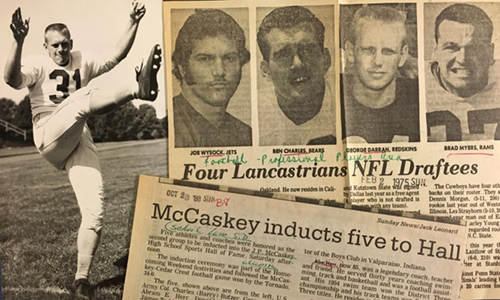George Darrah was a lifelong athlete, playing football, basketball, baseball, and golf at Franklin & Marshall College. During his senior year, he suffered a concussion which caused him to have seizures. He was drafted into the NFL by the Washington Commanders but his seizures led him to request a release from the team shortly after they drafted him. After leaving football, Darrah started a career with the Boys Club of America and became the Executive Director of the Dayton branch. In his late 60’s, Darrah began to have issues with his speaking and doctors diagnosed him with Alzheimer’s Disease. Later on a neurologist took an MRI and suggested the idea of Darrah having Chronic Traumatic Encephalopathy (CTE). Darrah passed away in 2017 at the age of 80. Dr. Thor Stein of the UNITE Brain Bank diagnosed him with stage 4 (of 4) CTE.

I was married to George Darrah for 63 years. We were both 18 right out of high school. He was not only my husband, and father to four children, but my very best friend.
George played all sports from little on, and he loved every minute of it. He graduated from high school in 1955 and was offered a full football scholarship by many large colleges and universities. He ended up staying in our hometown at a private all boys college called Franklin & Marshall. It was affiliated with a Protestant seminary. He played not only football but basketball, baseball, and golf for the college. In football he made All-East and then Little All American. He was honored with the Maxwell Award in 1958 in Philadelphia.
Near the end of his senior year he had a serious hit that left him unconscious. As was the practice in those days, they revived him and he got up and finished the game, as he played offense, defense and was the team’s punter. The next day as he complained about not feeling well, he had a grand mal seizure. Fortunately, the medicine controlled the seizures.
At the end of the season, George was drafted by the Washington Redskins. He went to their camp, officially made third string fullback and participated in the pre-conference games. He then shared with the administration that he daily took medicines for seizures and asked to be released.

George’s lifetime ambition was to work with children, especially the underprivileged population. After football, he immediately applied to Boys Clubs of America. He was hired, and we moved three times to work in Boys Clubs and ultimately George was named Executive Director of Dayton Boys (and later Girls) Clubs until he retired.
He was always led by his Christian beliefs, focusing on who he was and why. He led a Bible study outreach program from Ginghamsburg United Methodist Church to 30 folks in our home on Sunday evenings as a home group. His tombstone reads “Child of God”. He often asked someone how they would like to be remembered and when they asked him that question he always said as a Child of God. To lead folks to Christ was his main ambition in life.
Twelve years before George’s death, we started to notice things didn’t always come together for him, especially with speaking. It seemed he never lost the ability to know who he knew, or what he understood but speaking became more and more difficult. A doctor diagnosed him with Alzheimer’s disease. However about five years before his death a neurologist got involved at a hospital visit and requested an MRI. She told me he didn’t have Alzheimer’s but suggested that George might have CTE, frontal temporal injury.
George eventually refused to be cooperative in many ways and would refuse to do certain things. The main problem was refusing to take his seizure medicines so consequently he had to be admitted to an assisted living facility where the gastroenterologist inserting a G tube to administer his medicines. He eventually fell right in at the facility loving the young aids who loved him back. But he slowly lost ability to do many daily tasks. He finally succumbed to a viral infection he couldn’t conquer. He knew his family up until the end with big smiles.
It wasn’t a surprise when Dr. Thor Stein of the UNITE Brain Bank in Boston, informed us George was a Stage 4 (out of 4 stages) CTE patient. Years earlier, a neurologist noted atrophy in the front cortex on George’s MRI, and speculated that the atrophy was likely from playing football.
After the diagnosis, our children asked whether they need to be concerned about their own risks, and Dr. Stein reassured them that George’s CTE was most likely caused by his exposure from playing football and should, therefore, not increase their own risk of also suffering from dementia. His brain tissue will be used to help develop medicines to assist CTE patients while they are still living.
WHAT A LEGACY.


